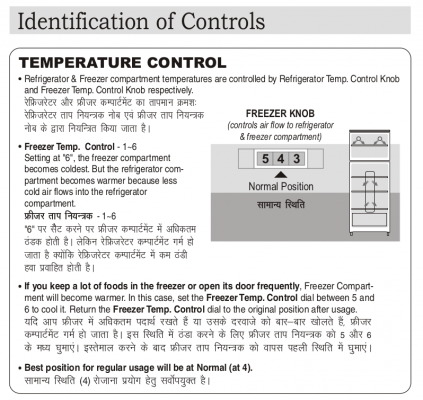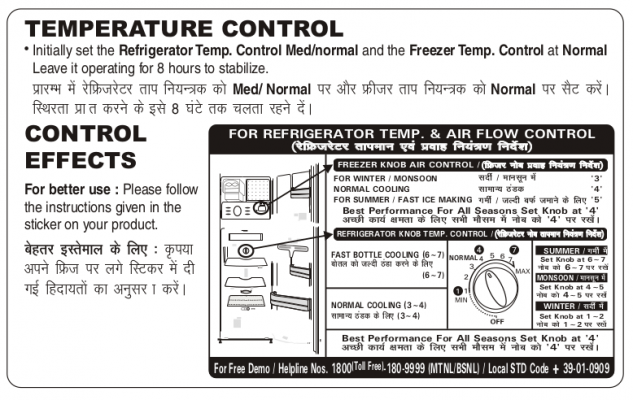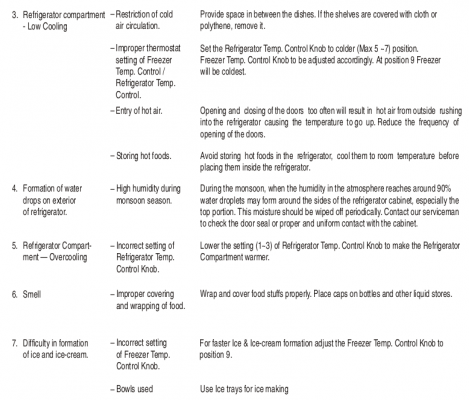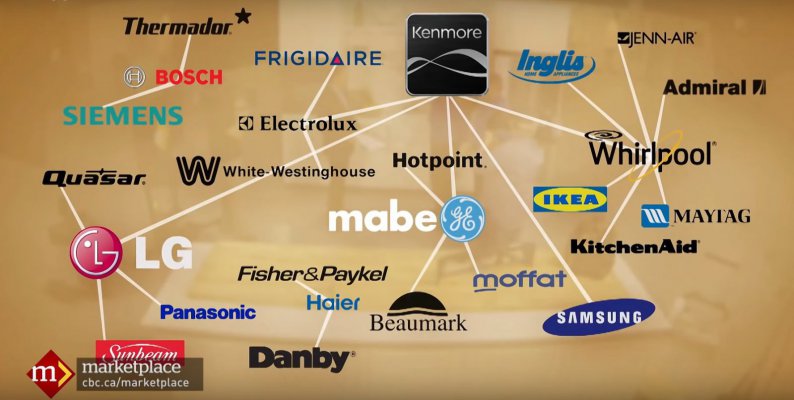Refrigerator energy consumption
- Thread starter jammy420
- Start date
You are using an out of date browser. It may not display this or other websites correctly.
You should upgrade or use an alternative browser.
You should upgrade or use an alternative browser.
- Status
- Not open for further replies.
blr_p
Quasar
The second box you mean which is above the vegetable box ?Didn't you miss the 'convertible box' for fruits in the 437/471L models?
I never had one with the kelvinator to begin with.
Found out the hard way that my fridge does not cool enough in the freezer section. I had bought ice cream and put it in freezer to freeze it and eat after an hour. After an hour I see it melting in puddle. Maybe the freezer was on defrosting mode but why should it melt stuff inside the freezer? I put a digital temperature meter in freezer and turned dial all way to lowest cooling which is 7 on the dial hoping the ice cream would freeze fast. No dice. After 3 hours the freezer was reading 0 degrees C and 16% humidity. wtf? Today moring I checked it and it was reading -4 C & 16% humidity. So the stupid freezer doesn't go lower than that. There was a small compartment in the freezer for fast chilling and no matter what temp is set in the freezer ( 1 -7) that area is around -3 C almost always. So seems I can save electricity by just using that small compartment to chill ice cream. But unfortunately, the ice cream even melted in that -3 C space and settled down. Looking at the ice cream carton it says to store at -18C.
How do new fridges get to -18 or -20 degrees while using less power?
How do new fridges get to -18 or -20 degrees while using less power?
blr_p
Quasar
which fridge is it ? brand & model #Found out the hard way that my fridge does not cool enough in the freezer section. I had bought ice cream and put it in freezer to freeze it and eat after an hour. After an hour I see it melting in puddle. Maybe the freezer was on defrosting mode but why should it melt stuff inside the freezer? I put a digital temperature meter in freezer and turned dial all way to lowest cooling which is 7 on the dial hoping the ice cream would freeze fast. No dice. After 3 hours the freezer was reading 0 degrees C and 16% humidity. wtf? Today moring I checked it and it was reading -4 C & 16% humidity. So the stupid freezer doesn't go lower than that. There was a small compartment in the freezer for fast chilling and no matter what temp is set in the freezer ( 1 -7) that area is around -3 C almost always. So seems I can save electricity by just using that small compartment to chill ice cream. But unfortunately, the ice cream even melted in that -3 C space and settled down. Looking at the ice cream carton it says to store at -18C.
How do new fridges get to -18 or -20 degrees while using less power?
Check your gaskets. Are they hard or soft. soft insulates better. If they're hard then its not doing its job. Time to replace them.
Check the back and ensure the evaporator coils are free of dust. You might need to do dusting & cleaning there.
Barring any other issues these two will have the biggest bearing on power consumption and consequent cooling.
which fridge is it ? brand & model #
Check your gaskets. Are they hard or soft. soft insulates better. If they're hard then its not doing its job. Time to replace them.
Check the back and ensure the evaporator coils are free of dust. You might need to do dusting & cleaning there.
Barring any other issues these two will have the biggest bearing on power consumption and consequent cooling.
It's a 262L LG frost free. Model is 262GL or GP something.
Gaskets are soft. The door frame heats up during cooling to ensure a magnetic seal too. Entire back is completely closed since its a frost free fridge.
blr_p
Quasar
How old is the fridge ?It's a 262L LG frost free. Model is 262GL or GP something.
Gaskets are soft. The door frame heats up during cooling to ensure a magnetic seal too. Entire back is completely closed since its a frost free fridge.
I plan on getting the LG guy to unscrew the back and dust around at least once every two years.
The Kelvinator could go as low as -10 if i pushed the dial to 4. Max was 7. Course the compressor would be working very often in that case.
So we used to keep it at 3 and this caused another problem which i only understood after i got the wireless thermometers.
The fridge would hover around 9 -10 degrees C, given how packed it was.
This meant any milk stored that was not boiled within 8 hours of delivery would curdle.
No surprise since the directions on the packet say to store at 4 degrees or colder. It never got that cold in the fridge section of the Kelvinator.
Had i realised this i'd have replaced it many years back. The FDA rule is no warmer than 4 degrees in the fridge and -18 in the freezer.
Never had this milk curdle problem with the new fridge. I set it to 1 degree this way it averages under 4 even on the door shelves.
So the point is if your freezer ain't doing its job, i'd worry about the contents of your fridge and how cold its keeping things there.
Last edited:
@adder, I had changed the gas a year or two back completely. The copper had corroded and there was a tiny pin like prick which had lead to the gas leaking out. Had to change a foot of copper and completely replace all gas with new one.
The fans in fridge and freezer are both working fine. I can feel it blow cold air 3-4 inches away from the vents.
@blr_p , the fridge is about 15-16 years old now. The fridge was kept at minimum cooling from when I bought it. Even when packed it was too cold for my liking if I kept it at more than 2 in fridge and 4 in freezer. Nothing spoiled in fridge even when there was 5-8 hours of power cuts in summer. Milk never spoilt. Curd never spoilt. I stay alone and had gone away for a week and even vegetables didn't get spoilt but got dehydrated a bit. This is after changing the gas in fridge.
I think maybe there is connection between fridge and freezer settings. The fridge gets extra cold air from the freezer through a large vent in the freezer bottom. Since I have kept the fridge main section setting at minimum, the fridge has to maintain that temp setting. So maybe it cannot cool down the freezer as much as the dial is set since it keeps rotating air from freezer to main compartment. If I blocked the vent in freezer, it would probably chill down very fast to -8 or even less probably. I don't know what effect it will bring on main compartment though.
The fans in fridge and freezer are both working fine. I can feel it blow cold air 3-4 inches away from the vents.
@blr_p , the fridge is about 15-16 years old now. The fridge was kept at minimum cooling from when I bought it. Even when packed it was too cold for my liking if I kept it at more than 2 in fridge and 4 in freezer. Nothing spoiled in fridge even when there was 5-8 hours of power cuts in summer. Milk never spoilt. Curd never spoilt. I stay alone and had gone away for a week and even vegetables didn't get spoilt but got dehydrated a bit. This is after changing the gas in fridge.
I think maybe there is connection between fridge and freezer settings. The fridge gets extra cold air from the freezer through a large vent in the freezer bottom. Since I have kept the fridge main section setting at minimum, the fridge has to maintain that temp setting. So maybe it cannot cool down the freezer as much as the dial is set since it keeps rotating air from freezer to main compartment. If I blocked the vent in freezer, it would probably chill down very fast to -8 or even less probably. I don't know what effect it will bring on main compartment though.
blr_p
Quasar
These dial settings confuse me because they are so un-intuitive. so i had to watch this video again

Freezer dial at 1 is coldest or warmest ?

It turns out the freezer dial is not a temperature setting but an air control regulator.
SO a setting of 1 as recommended for summer means the fridge is cool but the freezer is warm.
Huh !! it's this inverse relationship between the two that i fail to understand.
At a simple level its as if air intake for freezer is reduced so more cooling for the fridge and less for the freezer ?
But surely in summer i want BOTH cold and not have to choose between one or the other
There really is just one temperature setting and its situated in the fridge.
The dial in the freezer just decides how much cold air to let into the freezer. It is not a temperature setting.
In the freezer 7 means more cooling for the freezer than the fridge.
The fridge regulator makes more sense, higher numbers correspond to colder temperature settings. Higher number means compressor works more.
However there is an inverse relationship with the freezer air control dial which i'm not able to understand.
In the hot months they want low number in the fridge but high in the freezer and other way around in the cold months.
Earlier in the year mangoes kept ok with the slider on vegetables. If you keep fruits in the fridge then fresh zone at the top is not an acceptable setup for you.
Temperature is kept constant as its enclosed so does not change when door is open and hovers little about zero. Used for placing items for defrosting from the freezer. Or milk packets, cheese, bread and cold cuts. Conveniently located at the top instead of half way down.

 envirothink.wordpress.com
envirothink.wordpress.com
Where to get the equivalent in India ? A years supply here, hmm...
I had a power cut recently for eight hours. I was concerned my ice in the fridge would melt.
At the end of 8h, the temps in the freezer were 5 degrees and in the fridge it was 14. The ice seemed to have contracted a little maybe 10-20% smaller but otherwise still fine. The fridge still felt chilly and milk was cold to the touch. Pretty good. But its going on the inverter once i get that installed.
These digital thermometers only measure air temperature. A more accurate thermometer would be wet bulb type. So old school, coloured alcohol in a graduated thin glass tube more accurately represents what the food temperature really is. No digital available.
Fridges are pretty dry places. Humidity of just 16% as you found out. So the vegetable box traps moisture. About two weeks is the max for any produce stored in there.
Freezer dial at 1 is coldest or warmest ?
It turns out the freezer dial is not a temperature setting but an air control regulator.
SO a setting of 1 as recommended for summer means the fridge is cool but the freezer is warm.
Huh !! it's this inverse relationship between the two that i fail to understand.
At a simple level its as if air intake for freezer is reduced so more cooling for the fridge and less for the freezer ?
But surely in summer i want BOTH cold and not have to choose between one or the other

There really is just one temperature setting and its situated in the fridge.
The dial in the freezer just decides how much cold air to let into the freezer. It is not a temperature setting.
So according to the above diagrams. A setting of 7 where ?I put a digital temperature meter in freezer and turned dial all way to lowest cooling which is 7 on the dial hoping the ice cream would freeze fast. No dice. After 3 hours the freezer was reading 0 degrees C and 16% humidity. wtf?
In the freezer 7 means more cooling for the freezer than the fridge.
A setting of 2 in the fridge is setting the temperature higher (low number means less cooling) in the fridge. That corresponds to the first diagram. Low numbers in winter, high in summer.The fridge was kept at minimum cooling from when I bought it. Even when packed it was too cold for my liking if I kept it at more than 2 in fridge and 4 in freezer. Nothing spoiled in fridge even when there was 5-8 hours of power cuts in summer. Milk never spoilt. Curd never spoilt. I stay alone and had gone away for a week and even vegetables didn't get spoilt but got dehydrated a bit. This is after changing the gas in fridge.
The fridge regulator makes more sense, higher numbers correspond to colder temperature settings. Higher number means compressor works more.
From the diagram above. The fridge temperature setting which is the only "temperature" setting in the fridge should be kept low in the cold months and high in the hotter months. This makes sense.I think maybe there is connection between fridge and freezer settings. The fridge gets extra cold air from the freezer through a large vent in the freezer bottom. Since I have kept the fridge main section setting at minimum, the fridge has to maintain that temp setting. So maybe it cannot cool down the freezer as much as the dial is set since it keeps rotating air from freezer to main compartment. If I blocked the vent in freezer, it would probably chill down very fast to -8 or even less probably. I don't know what effect it will bring on main compartment though.
However there is an inverse relationship with the freezer air control dial which i'm not able to understand.
In the hot months they want low number in the fridge but high in the freezer and other way around in the cold months.
Post automatically merged:
the convertible box in my fridge has been moved to the top and is a sliding box with a pivoting door called fresh zone. It's the second fresh zone compartment to the one at the bottom for vegetables or fruits. I prefer this arrangement as it's less cluttered. Curious as to fruits you put in the fridge ?Didn't you miss the 'convertible box' for fruits in the 437/471L models?
Earlier in the year mangoes kept ok with the slider on vegetables. If you keep fruits in the fridge then fresh zone at the top is not an acceptable setup for you.
Temperature is kept constant as its enclosed so does not change when door is open and hovers little about zero. Used for placing items for defrosting from the freezer. Or milk packets, cheese, bread and cold cuts. Conveniently located at the top instead of half way down.

BluApple – the easy way to keep produce fresh longer
In our throwaway society, everything is fair game. The Organic Consumers Association reports that Americans toss out on average $600 worth of food each year. That’s over 100 billion pounds of fresh…
Where to get the equivalent in India ? A years supply here, hmm...
Post automatically merged:
Maybe its time you got a new one ?the fridge is about 15-16 years old now.
Interesting so 20yr old models also had the ever cool feature.Nothing spoiled in fridge even when there was 5-8 hours of power cuts in summer. Milk never spoilt. Curd never spoilt. I stay alone and had gone away for a week and even vegetables didn't get spoilt but got dehydrated a bit. This is after changing the gas in fridge.
I had a power cut recently for eight hours. I was concerned my ice in the fridge would melt.
At the end of 8h, the temps in the freezer were 5 degrees and in the fridge it was 14. The ice seemed to have contracted a little maybe 10-20% smaller but otherwise still fine. The fridge still felt chilly and milk was cold to the touch. Pretty good. But its going on the inverter once i get that installed.
These digital thermometers only measure air temperature. A more accurate thermometer would be wet bulb type. So old school, coloured alcohol in a graduated thin glass tube more accurately represents what the food temperature really is. No digital available.
Fridges are pretty dry places. Humidity of just 16% as you found out. So the vegetable box traps moisture. About two weeks is the max for any produce stored in there.
Last edited:
rdst_1
Juggernaut
It's very simple. The dial in the refrigerator compartment controls the temperature. The dial in the freezer compartment controls the opening and closing of a vent. Depending upon how cold you want the refirgerator section, you open the vent that much. The evaporator coil is in the freezer section. A fan blows air over the coil and this air is circulated in both the freezer and refrigerator. If you don't want your refrigerator to be cold but your freezeer to be cold, just set the temperature low and the vent at the lowest setting. It is counter-intuitive that the temperature dial is provided in the refrigerator section when it controls how cold the freezer will be and and the vent control is in the freezer when it controls how cold the refrigerator section will be.
blr_p
Quasar
ok so lets use the diagram above.It's very simple. The dial in the refrigerator compartment controls the temperature. The dial in the freezer compartment controls the opening and closing of a vent. Depending upon how cold you want the refirgerator section, you open the vent that much.
In summer you want the fridge & freezer colder. They recommend setting to 1 in the freezer & higher fridge setting. This means Fridge cooler & freezer warmer. The un-intuitive bit is 1 in the freezer corresponds to larger vent opening into the fridge.
What i don't get is why would I want the fridge colder and the freezer warmer ? i want both to be colder in hotter climate and less cold in colder climate but it seems there has to be a trade off.
Where i can see some utility with the trade-off is if you wanted to cool one area fast. But that's it. Just one area. Then it would make sense to send more cold air into the desired place .Either fridge or freezer.
Setting fridge temp to a low number means less cooling in the fridge. If i further want that air not to come into the fridge i have to close the vent in the freezer so freezer gets colder this now corresponds to 6. I guess this looks like what 6pack did. Low in the fridge and high number in the freezer means colder freezer for a setting of 1 or 2 in the fridge.The evaporator coil is in the freezer section. A fan blows air over the coil and this air is circulated in both the freezer and refrigerator. If you don't want your refrigerator to be cold but your freezeer to be cold, just set the temperature low and the vent at the lowest setting.
Way i understood it is the temperature dial controls the temperature or lets say some minimum for both fridge & freezer. The freezer control modifies the share of how cold one gets at the expense of the other. Without temperature readings you have no clue how much warmer the fridge got or how much colder the freezer became and vice versa.It is counter-intuitive that the temperature dial is provided in the refrigerator section when it controls how cold the freezer will be and and the vent control is in the freezer when it controls how cold the refrigerator section will be.
I guess the question is why two dials at all then. If just one could do the job.
It would seem to me the simplest setting is to keep the freezer vent half way. I think this is 4 or (normal) and leave it at that.
And just regulate at the bottom for how cold or not desired in both places.
Last edited:
blr_p
Quasar
Let's compare yoursFor me in the booklet, the settings are as below.
View attachment 82933
View attachment 82934
Also in troubleshooting section
View attachment 82935
Seems like setting the freezer at 4 is recommended for all climates.
With the one i posted earlier
Do you see the difference ?
Yours in summer says to increase the freezer dial which makes sense.
The one i posted from the video says to decrease it for summer which is the opposite.
The next graphic agrees with yours but contradicts the one i posted
Lower number in the freezer is less cooling and higher number is more cooling.
Last edited:
Newer fridges can vary the compressor speed, In my samsung which I believe as two fans the setting starts at -15C to -23C for the freezer.
In the old 2011 panasonic that I have there is just 3 speed setting for the thermostat temperature. Then there is a lever to divert the air to fridge more or freezer more or both .
In your Lg, I still think the gas has leaked or the compressor is on its last legs, since you said before it was cooling even at setting 2.
In the old 2011 panasonic that I have there is just 3 speed setting for the thermostat temperature. Then there is a lever to divert the air to fridge more or freezer more or both .
In your Lg, I still think the gas has leaked or the compressor is on its last legs, since you said before it was cooling even at setting 2.
blr_p
Quasar
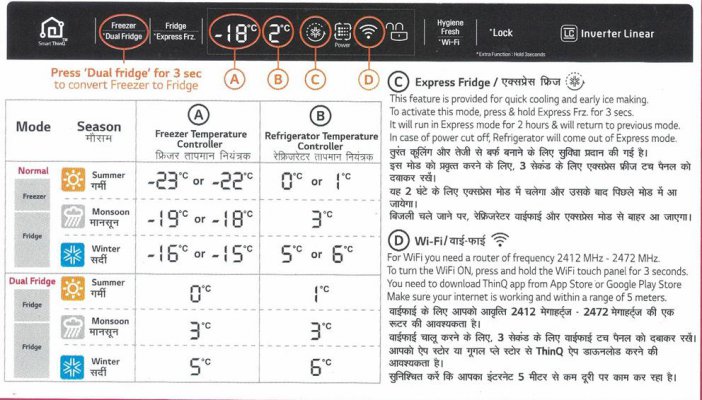
These are the recommended temperature settings by LG for my fridge.
I'm not sure why temp settings need to be changed for the different seasons.
Once i decided what temperatures i want that should be it regardless of the season, right ?
If i set the fridge to be 1 and freezer to -18 then that should be it for the rest of the year.
If the weather is warmer i expect the fridge to work harder to keep those temp settings than when weather is cooler.
Post automatically merged:
I put a digital temperature meter in freezer and turned dial all way to lowest cooling which is 7 on the dial hoping the ice cream would freeze fast. No dice. After 3 hours the freezer was reading 0 degrees C and 16% humidity. wtf? Today moring I checked it and it was reading -4 C & 16% humidity. So the stupid freezer doesn't go lower than that.
Looking at the ice cream carton it says to store at -18C.
Just had a thought looking at specs of temperature meters. Do you know what the tolerances are for the meter you used ? how low a temperature can it record
i used temp monitors explicitly designed for fridges & freezers that can go as low as -40 degrees C and as high as 37
Could it be the temp meter you used goes no lower than -4 ?
Meaning your fridge got colder just that it could not be measured with what you used.
Last edited:
blr_p
Quasar
That link does not work
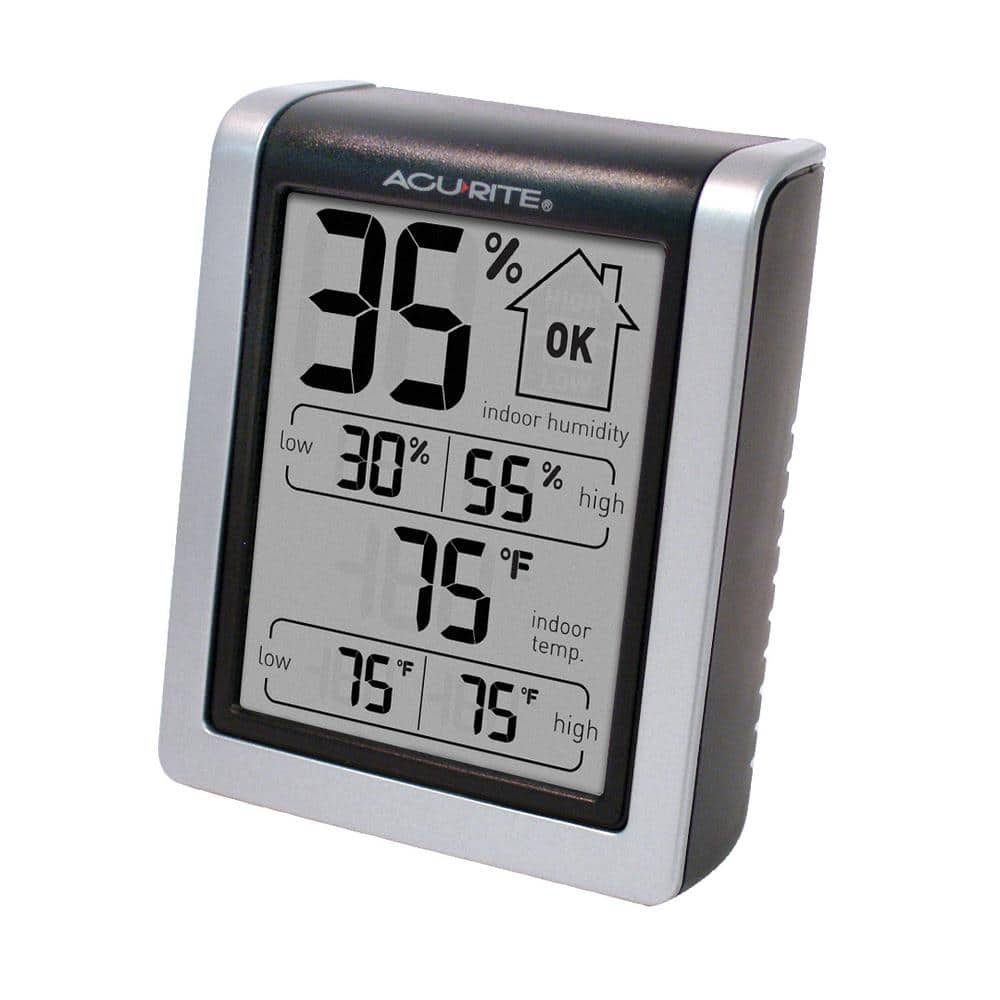
AcuRite Digital Humidity and Temperature Comfort Monitor 00613 - The Home Depot
Ensuring proper indoor humidity has important skin, allergen and other health benefits by inhibiting the growth of mold, bacteria, viruses, fungi, mites and other asthma inducing agents. The AcuRite Digital
www.homedepot.com
blr_p
Quasar
It's funny but i kinda suspected you did that, see this
AcuRite Digital Humidity and Temperature Comfort Monitor 00613 - The Home Depot
Ensuring proper indoor humidity has important skin, allergen and other health benefits by inhibiting the growth of mold, bacteria, viruses, fungi, mites and other asthma inducing agents. The AcuRite Digitalwww.homedepot.com
- Reads indoor temperatures ranging from 32 to 122 degrees F
I'm surprised it showed -4 as it cannot read below 0
This is what i wanted to post but removed from my last
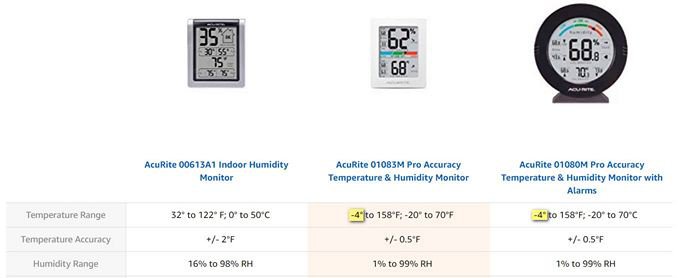
So... what thermometer to use ?
Aptechdeals AP-IS11A001 Mini LCD digital Thermometer Sensor Wired for Room Temperaure/Fridges: Amazon.in: Industrial & Scientific
Aptechdeals AP-IS11A001 Mini LCD digital Thermometer Sensor Wired for Room Temperaure/Fridges: Amazon.in: Industrial & Scientific
www.amazon.in
Cheap enough. Claims it can go down to -50 but this review proves it too cannot go below zero
Cooking Thermometers Fridge Freezer Thermometer with Colour Coded Zones : Amazon.in: Home & Kitchen
Cooking Thermometers Fridge Freezer Thermometer with Colour Coded Zones : Amazon.in: Home & Kitchen
www.amazon.in
With these analog ones is it takes at least 15 minutes to equilibrate
Last edited:
- Status
- Not open for further replies.


